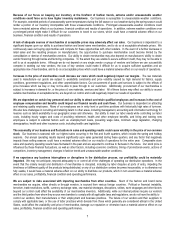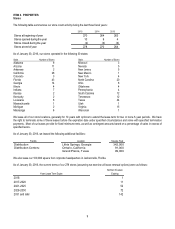Stein Mart 2015 Annual Report Download - page 19
Download and view the complete annual report
Please find page 19 of the 2015 Stein Mart annual report below. You can navigate through the pages in the report by either clicking on the pages listed below, or by using the keyword search tool below to find specific information within the annual report.17
Off-Balance Sheet Arrangements
We have outstanding standby letters of credit totaling $6.4 million securing certain insurance programs at January 30, 2016. If specified
conditions were to occur under these arrangements, we would be required to satisfy the obligations in cash. Due to the nature of these
arrangements and based on historical experience, we do not expect to make any payments; therefore, the letters of credit are excluded
from the preceding table. There are no other off-balance sheet arrangements that could affect our financial condition.
Critical Accounting Policies and Estimates
The preparation of our consolidated financial statements requires us to make estimates and assumptions that affect the reported amounts
of assets, liabilities, expenses and related disclosure of contingent assets and liabilities. We base our estimates and judgments on
historical experience and other relevant factors, the results of which form the basis for making judgments about the carrying values of
assets and liabilities that are not readily apparent from other sources. While we believe that the historical experience and other factors
considered provide a meaningful basis for the accounting policies applied in the preparation of the consolidated financial statements, we
cannot guarantee that our estimates and assumptions will be accurate, which could require adjustments of these estimates in future
periods. A summary of the more significant accounting policies follows.
Retail Inventory Method and Inventory Valuation. Inventories are valued using the lower of cost or market value, determined by the
retail inventory method. Under the retail inventory method (“RIM”), the valuation of inventories at cost and the resulting gross margins are
calculated by applying a cost-to-retail ratio to the retail value of inventories. RIM is an averaging method that is widely used in the retail
industry. The use of the retail inventory method results in valuing inventories at lower of cost or market as permanent markdowns are
currently taken as a reduction of the retail value of inventories. Inherent in the RIM calculation are certain significant management
judgments and estimates including, among others, merchandise markon, markup, markdowns and shrinkage, which significantly affect the
ending inventory valuation at cost as well as the corresponding charge to cost of goods sold. In addition, failure to take appropriate
permanent markdowns currently can result in an overstatement of inventory.
We perform physical inventory counts at all stores once per year, in either the summer or January. Included in the carrying value of
merchandise inventories between physical counts is a reserve for estimated shrinkage. That estimate is based on historical physical
inventory results. The difference between actual and estimated shrinkage may cause fluctuations in quarterly results, but was not
significant in 2015 and 2014.
Vendor Allowances. We receive allowances from some of our vendors primarily related to markdown reimbursement, damaged/defective
merchandise and vendor compliance issues. Vendor allowances are recorded when earned. Allowances received from vendors related to
profitability of inventory recently sold are reflected as reductions to cost of merchandise sold in the later of the period that the merchandise
markdown is incurred or the allowance is negotiated. Allowances received from vendors related to damaged/defective inventory are
reflected as reductions to the cost of merchandise as it is received. Allowances received due to vendors’ failure to comply with our policies
(primarily violations of shipping and merchandise preparation requirements) are reflected as a reduction of the cost of the merchandise
when identified during the receiving process. Although it is unlikely that there will be a significant reduction in historical levels of vendor
support, if a reduction were to occur, we could experience higher cost of merchandise sold.
Impairment of Long-Lived Assets. Long-lived assets are reviewed for impairment whenever events or changes in circumstances
indicate that the carrying amount of an asset may not be recoverable. Factors used in the review include management’s plans for future
operations, recent operating results and projected cash flows. For long-lived assets held for use, an impairment loss is recognized if the
sum of the future undiscounted cash flows from the use of the assets is less than the carrying value of the assets (net of deferred rent
credits). The amount of the impairment charge is the excess of the carrying value of the asset over its fair value. Impairment reviews are
performed for individual stores during the fourth quarter, or more frequently should circumstances change. A significant decrease in cash
flows could result in an increase in asset impairment charges. During 2015, 2014 and 2013, we recorded $2.0 million, $1.5 million and
$2.2 million, respectively, in asset impairment charges.
Store Closing Costs. We record costs associated with store closing activities when they are incurred, generally the cease-use date.
Lease termination costs are recorded net of estimated sublease income that could reasonably be obtained for the properties. In the event
we are not successful in subleasing closed store locations, additional store closing costs may be recorded. During 2015, we recorded a
nominal amount of store closing costs, net of impairments. During 2014 and 2013, we recorded $1.0 million and $0.1 million, respectively,
in store closing charges, net of impairments.
Insurance Reserves. We use a combination of insurance and self-insurance for various risks including workers’ compensation, general
liability and associate-related health care benefits. We are responsible for paying the claims that are less than the insured limits. The
reserves recorded for these claims are actuarially estimated based on claims filed and claims incurred but not reported. These reserve
estimates are adjusted based upon actual claims filed and settled. The estimated accruals for these reserves could be significantly
affected if future claims differ from historical trends and other actuarial assumptions. As of January 30, 2016 and January 31, 2015,
insurance reserves of $18.2 million and $16.4 million, respectively, were included in Accrued expenses and other current liabilities and
























